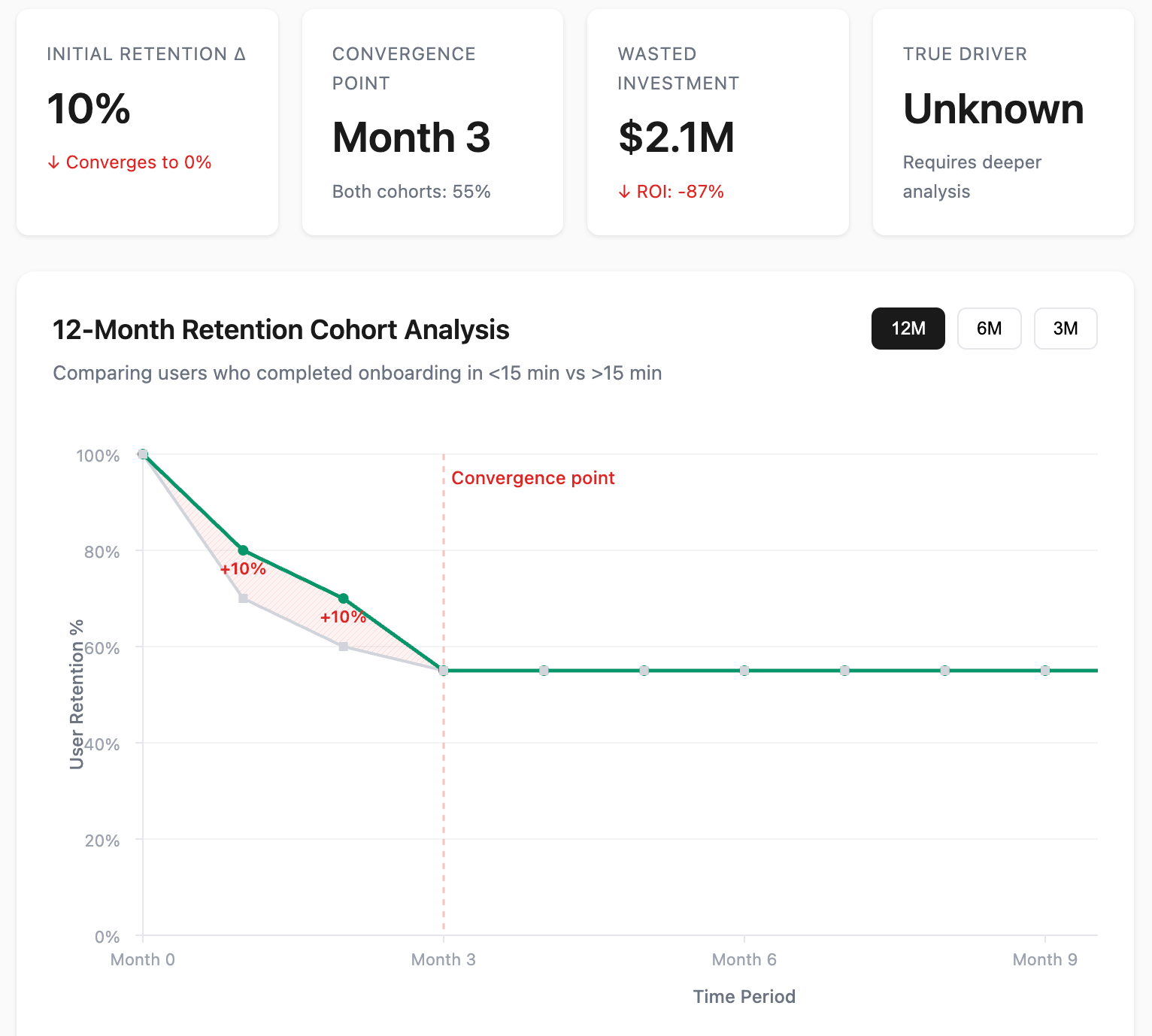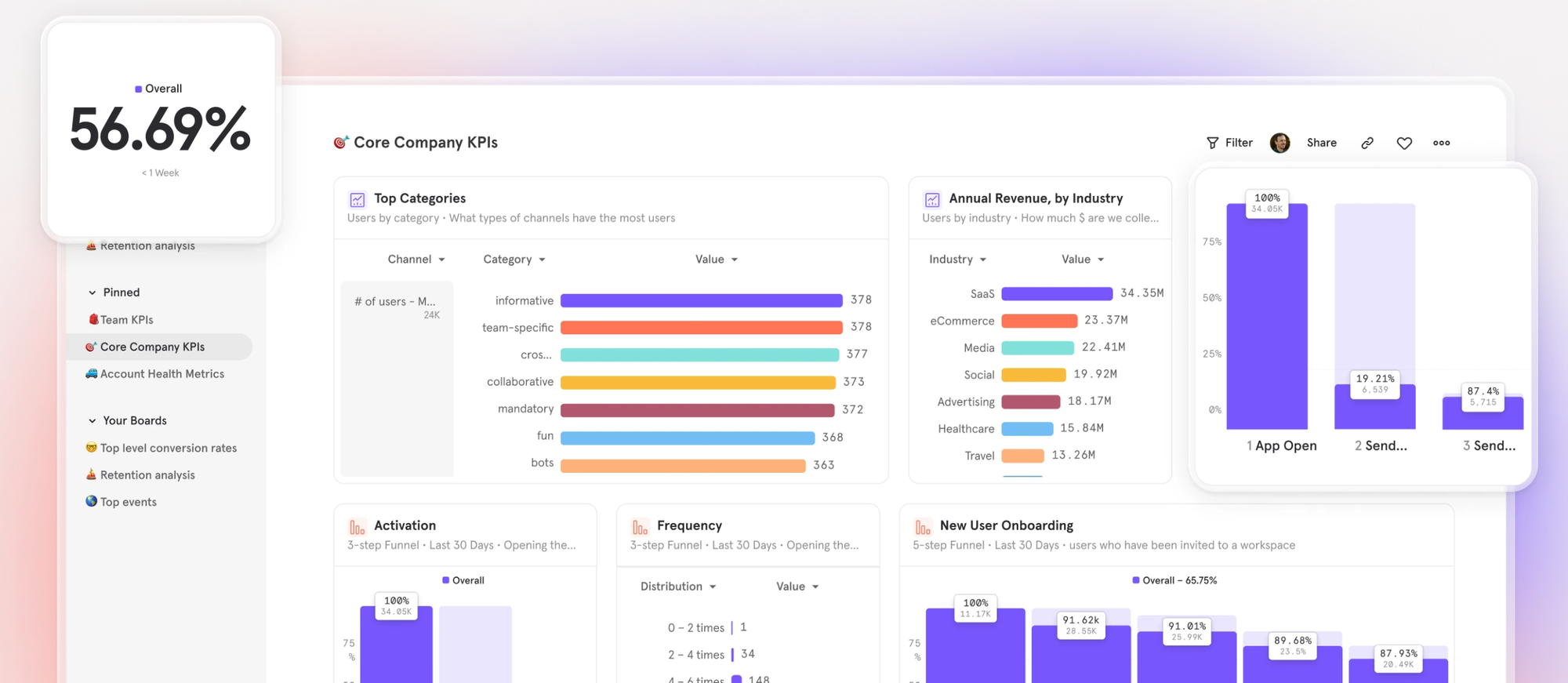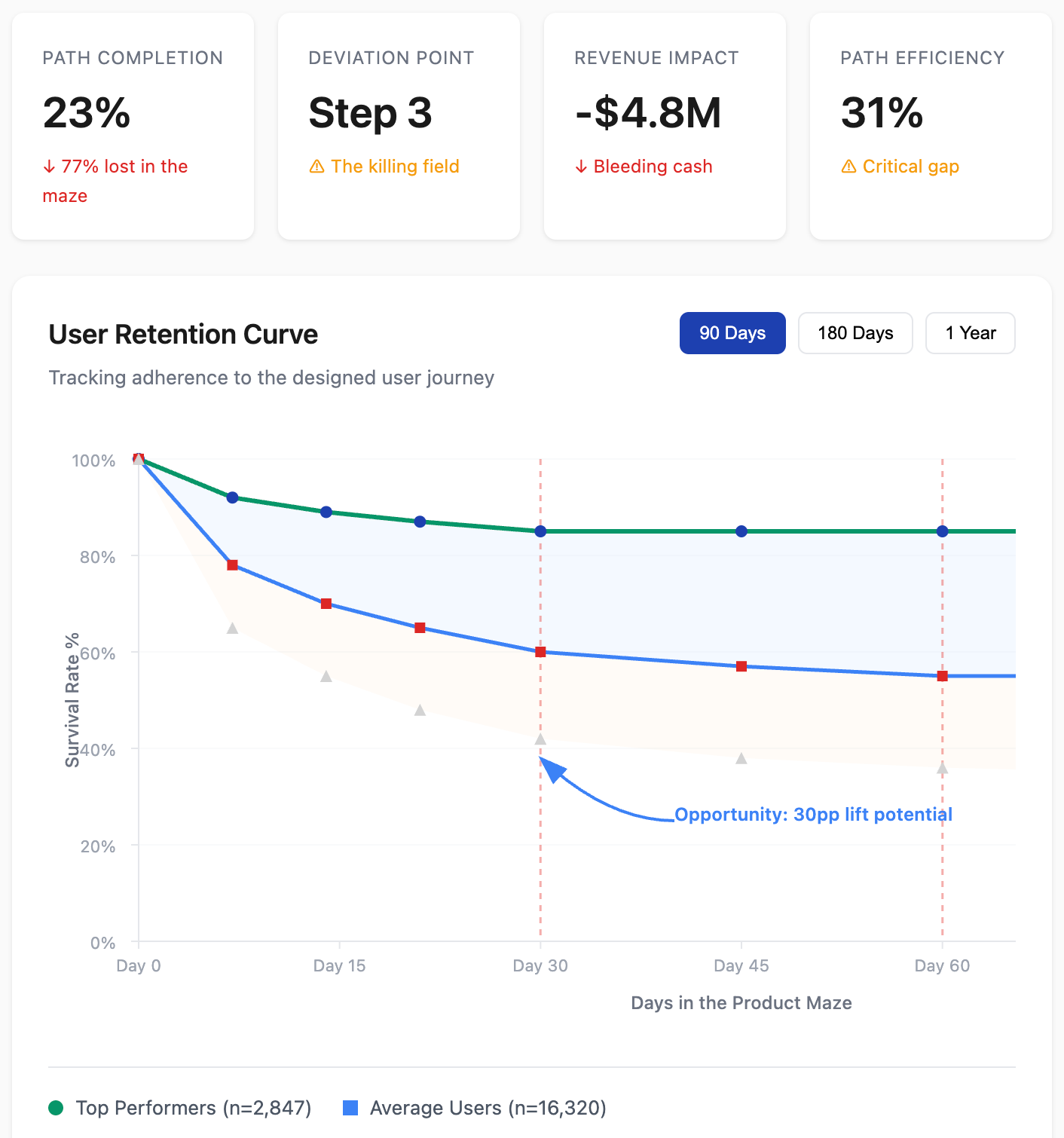The $2M Retention Mistake Every SaaS Founder Makes

Hola, habla statistics? – No? This is for you.
I've been talking to many of you, founders, operators, VCs, and pretenders. Thank you for the love and appreciation.
I started this retention series because it's something that companies should define and measure from day 0. To my surprise a series B startup reached out to me and I've been helping them for a couple of weeks now. I'll keep them anonymous because you know: priest's vow of silence, attorney-client confidentiality and NDAs. For the sake of this story, let's call them: Pear, Inc.
This is the story.
(so dramatic, such wow)
Two PMs and an Engineer walk into a bar. Just kidding—PMs and engineers never hang out.
Now let's get real. Series B startup, 8 months, 2 million spent rebuilding entire onboarding flow. Why? Because "users who complete the setup in under 15 minutes have 30% higher retention in month 12".
The result? Activation went up 10% but retention in month 3 didn't move an inch from previous setup. Note: month 3 because, 12 months haven't elapsed yet. 2 million dollars in precious engineering time gone to waste. Cost of opportunity? Let's not even go there.

This sounds familiar? If the answer is no, let me interview you and teach me master.
So what went wrong? The team mistook correlation for causation.
Those speedy users weren't loyal because of the quick onboarding. Turns out they were already sophisticated buyers with dedicated implementation teams. Fast onboarding was a symptom of strong initial intent, not the cause.What does this mean? Correlation was real. Causation? Imaginary. The $2m? Gone. Was it all negative? No, kudos to the GTM team, they nailed ICP on those speedy users.
Welcome to the graveyard of statistical illiteracy—where bright-eyed startups bleed out slow and quiet.
Your Dashboard Is Lying

Every good founder I know stares at dashboards like ancient priests reading sacred texts, desperately seeking patterns that predict the future. But here's the brutal truth: most of what you see is noise dressed up as signal.
Let's understand causation vs correlation. I did study actuarial science (believe it or not) so trust me on this one.
Correlation is the normalization of when two variables move in tandem or opposite directions.
Causation is the direct influence from one event to produce or contribute to another event.
The real killers lurk beneath these surface-level observations, wearing the mask of "insights" while bleeding your runway dry.
3 retention myths that are quietly killing your startup.
Myth 1: Feature fetish.
Users who use feature X have 2x more retention, let's build more X.
I think this is the most common one. This is startup suicide by product bloat. Loyal users don't stay because they use more features—they use more features because they're already committed. You're watching survivors bias in real-time, then building your entire roadmap around it.
The users exploring every corner of your product? They arrived with intent, budget, and pressing needs. Meanwhile, you're cramming features down the throats of tourists who were never going to convert anyway.

You're not asking yourself the right questions. Pear, Inc viewed onboarding as causation. But the real causation was behavior over time. Good onboarding is time to value (aha moment). The real insight was lying right there for Pear, Inc just couldn't see it clearly.
Myth 2: The Engagement Illusion
"Daily active users show higher net dollar retention."
Congratulations, you've discovered that companies with money don't use products they pay for. This isn't insight—it's, cognitive bias. Those monthly payments are not flowing because your product is great; they're paying because their CFO signed a six-figure contract and someone's job depends on adoption. Your job is to make everyone in the company adopt it and use it as cocaine in the 80's Corporate America. While your product may genuinely provide value, realize much of your usage data reflects institutional inertia, not pure product love.
You're not measuring product-market fit. You're measuring sunk cost fallacy with a ChatGPT wrapper.
Pear, Inc. didn't understand the causation of the churn.
We signed a huge enterprise deal, with a Fortune 500 company. Month 2 the CFO called me and said: "man I'm very sorry but we will have to cancel the deal next month".
The founder was surprised. He had the right champion, the C-level was happy with the deal, DAU/MAU was >80% – everything seemed aligned. The problem? They got DAUs without WOWs. But actual end-users weren’t engaging deeply or correctly with the product.

Users were getting stuck, and no one noticed. The activation from this customer was not even close to their average ones. Engagement is frequency and habit. Track your events properly, or just raw dog your console log, but measure it.
Myth 3: The Seasonality Blindness
"Our Q1 onboarding improvements boosted retention 15%!"
Every January, budgets reset and companies go on spending sprees like suburban moms at Target. That retention bump you're attributing to your "revolutionary" onboarding? It's the same phenomenon that makes gym memberships spike after New Year's.
Your product didn't improve. The calendar turned. But sure, tell your board it was the new progress bar.
Understand your product seasonality.
The 30-Second Sanity Check That Could Save Millions
Before you bet your startup on a correlation, perform this thought experiment:
"If I randomly split users and changed only this variable, would retention truly differ?"
Can't answer with confidence? Then you're about to join the $2 million club of statistical casualties.
The Uncomfortable Truth About What Actually Works
1. Embrace Experimental Brutality
Stop trusting your gut. This one is tough, I do believe in gut feeling when building product, but in specific things, like taste. That being said, focus on the numbers that matter and acid test them often. Do randomized controlled trials when numbers don't add up. Real A/B tests—not the bastardized versions where you test on different segments and call it science. Think like a statistician, great founders do.
2. Control for Everything
Company size. Industry. Spending cycles. Time of year. User sophistication. Control for these variables or prepare to explain to investors why you spent their money chasing phantoms. Narrow down your ICP variables and track them. Is it fun? No. Will it help? Yes.
3. Track What Matters, Not What's Easy
Time-to-value. Activation milestones that predict revenue. Behavioral signals that separate tourists from buyers. Stop celebrating vanity metrics that make you feel good while your startup bleeds out. focus on what matters.
4. Worship at the Altar of Cohort Analysis
Aggregate data is where insights go to hide. Cohort analysis is where they're forced into the light. Track user groups through time, not time across user groups. Track cohort product usage. Not sure how to do it or where to start? I'd be more than happy to help. Shoot a DM at [email protected] I'll sign any NDA you want.
The Final Diagnosis
Here's what nobody wants to admit: Most "data-driven" startups are just correlation chasers with better dashboards. They mistake measurement for understanding, correlation for causation, and activity for progress.
That $2 million startup? They're not alone. They're part of an epidemic of founders who'd rather feel smart than be rigorous. Who'd rather have answers than ask better questions.
The cure isn't complicated. It's just uncomfortable. It requires admitting that most of your "insights" are mirages, your metrics are misleading, and your intuition is probably wrong.
But hey, at least your dashboard looks impressive while your startup burns.

Help your homeboy Aldo.
If you got this far, I would like to think this was valuable so I have an ask for you: I’m doing deep research on what “good retention” actually means across verticals and stages. If you’re down to share your numbers anonymously, publicly or privately (anything is welcome), DM me. I’ll help tear it down and build it better with you.
Why should you share it with yours truly? I’ve been genuinely surprised by how many VCs are sliding into my DMs asking for intros to founders that understand and have good retention.
I’ll see you next week with more dad jokes and retention talk.
-Aldouki. statistician and former child.
Was the post valuable? Subscribe. Need help? Shoot a dm [email protected]

